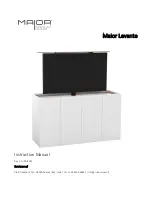
67
Troubleshooting
The problems described below are not always caused by malfunctions. Check the TV again before having the TV
serviced.
Problem
Possible Solution
• No power.
• Is the AC cord disconnected? (See page 12.)
• Has the power been turned on? (See page 16.)
• When the power switch does not work, remove the power plug and insert it again,
and press
POWER
a
on the TV after waiting more than fi ve seconds.
• Unit cannot be operated.
• External infl uences such as lightning, static electricity, etc., may cause improper
operation. In this case, operate the unit after fi rst turning the power off the TV or
unplugging the AC cord and re-plugging it in after 1 or 2 minutes.
• Remote control unit does not
operate.
• Are batteries inserted with polarity (
e
,
f
) aligned? (See page 15.)
• Are batteries worn out? (Replace with new batteries.)
• Are you using it under strong or fl uorescent lighting?
• Is a fl uorescent light shining on the remote control sensor?
• Picture is cut off.
• Is the image position correct? (See page 36.)
• Are screen mode adjustments such as picture size made correctly? (See pages 31,
32, 55 and 63.)
• Strange colour, light colour, or
dark, or colour misalignment.
• Adjust the picture tone. (See pages 34 to 36.)
• Is the room too bright? The picture may look dark in a room that is too bright.
• Check the colour system setting. (See pages 22 and 52.)
• Check the “HDMI auto view” setting. (See page 50.)
• Power is suddenly turned off.
• The unit's internal temperature has increased.
Remove any objects blocking the vent or clean.
• Check the “ECO” setting. (See pages 30 and 31.)
• Is the sleep timer set? (See page 30.)
• No picture.
• Is the connection to external equipment correct? (See pages 13 and 14.)
• Is the correct input selected? (See page 51.)
• Is the picture adjustment correct? (See pages 34 to 36.)
• Is the antenna connected properly? (See page 12.)
• Is “On” selected in “Audio only”? (See page 25.)
• No sound.
• Is the volume too low? (See page 20.)
• Make sure that headphones are not connected. (See page 10.)
• The TV sometimes makes a
cracking noise.
• This is not a malfunction. This happens when the cabinet slightly expands and
contracts according to changes in temperature. This does not affect the TV's
performance.
• Cannot select the desired channel. • Switch between Digital TV and Analogue TV modes.
Appendix
Cautions regarding use in high and low temperature environments
• When the unit is used in a low temperature space (e.g. room, offi ce), the picture may leave trails or appear slightly delayed.
This is not a malfunction, and the unit will recover when the temperature returns to normal.
• Do not leave the unit in a hot or cold location. Also, do not leave the unit in a location exposed to direct sunlight or near a
heater, as this may cause the cabinet to deform and the LCD panel to malfunction.
Storage
temperature:
f
20°C to
e
60°C.
Troubleshooting-Digital broadcasting
Problem
Error code
Possible Solution
• No picture or no sound.
—
• Is the correct Input source selected? (See page 51.)
• Block noise appears on the screen.
• Is the antenna pointing in the correct direction?
• Check the “Signal strength” and “Quality”. (See page 17.)
• Are physical objects blocking the antenna?
• Is the antenna or antenna cable compatible with DTV broadcast?
• DTV broadcasts cannot be received.
E202
• Is the DTV antenna set up properly?
• Is the antenna cable connected properly? (See page 12.)
• Is the channel settings correct? (See page 17.)
• A specifi c channel cannot be received.
—
• Check the “Signal strength” and “Quality”. (See page 17.)
• No broadcast now
E203
• Check the current broadcast.
40LE820X_en_au.indd 67
40LE820X_en_au.indd 67
2010/06/18 16:13:02
2010/06/18 16:13:02










































